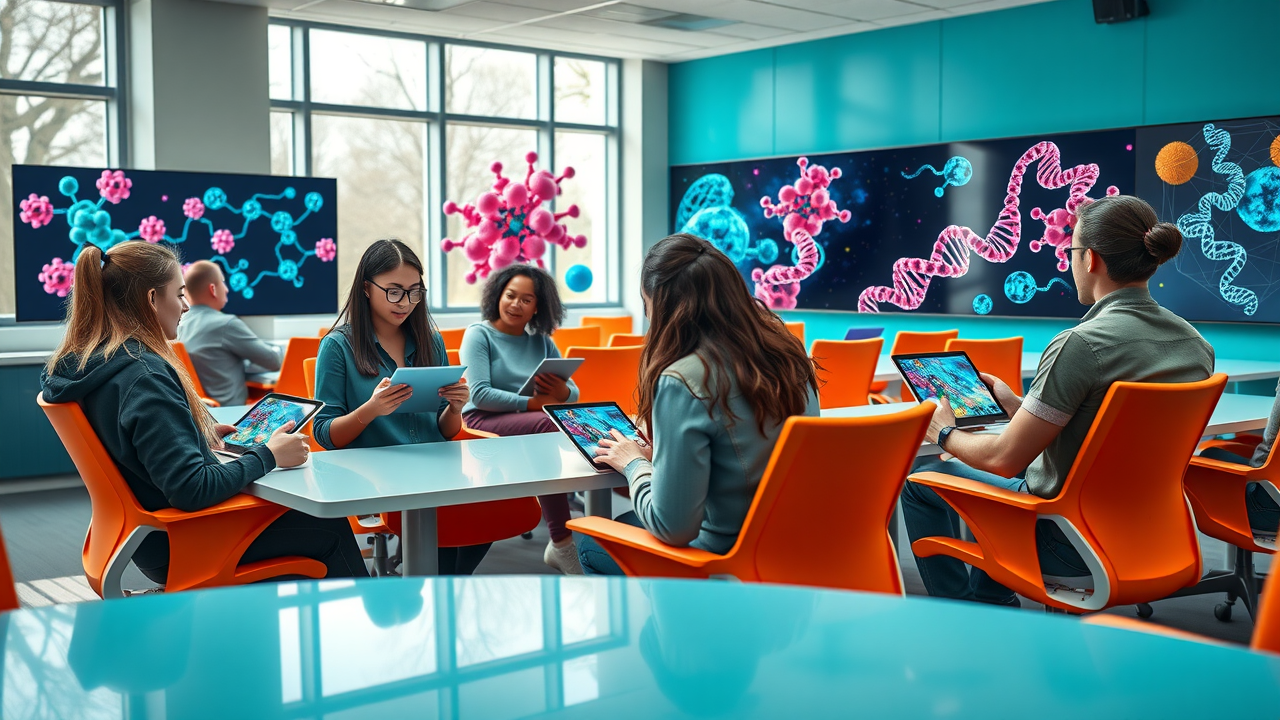Active learning classroom design in higher education is a game-changer, with the potential to boost student retention rates by up to 20% compared to traditional lecture halls. This significant increase, particularly in STEM fields (Freeman et al. 2014, PNAS), is just one of the many benefits of this innovative approach. Today's universities are embracing this shift, replacing traditional fixed-seating arrangements and chalkboards with dynamic spaces that foster technology-rich, flexible, and collaborative learning. Step into this classroom revolution, where students are not just passive listeners but active participants, builders, and problem-solvers.
Discover the Transformative Power of Active Learning Classroom Design for Higher Education
The traditional classroom environment, characterized by rigid rows and passive lectures, is undergoing rapid evolution. Studies now confirm what many educators have long suspected: these outdated layouts can actually hinder student participation and learning outcomes. In contrast, active learning classroom design for higher education is leading this transformation, leveraging collaborative learning environments and cutting-edge technology to engage students in real-world scenarios and hands-on projects.
Research shows that classrooms designed for active engagement significantly boost student participation and information retention, particularly in STEM fields, with growing evidence of similar benefits in liberal arts disciplines (Freeman et al. 2014, PNAS). As universities and state university systems invest in these modern learning spaces, they're not just changing the look of the room; they're reshaping the entire learning experience for faculty and students alike.

Active learning classroom design in higher education has been shown to increase student retention rates by up to 20% in some cases, particularly in STEM disciplines. EDUCAUSE case studies and research summaries support these findings alongside peer-reviewed studies like Freeman et al. (2014, PNAS).
What You'll Learn About Active Learning Classroom Design for Higher Education
The core principles behind active learning classroom design for higher education
The impact of physical space and flexible furniture on learning environments
Strategies for implementing effective active learning spaces
Current best practices and examples from top state universities
Answers to key questions about designing active learning environments
From Lecture to Lab: The Evolution of Learning Spaces in Higher Education
Defining Active Learning Classroom Design for Higher Education
Active learning classroom design is a deliberate approach to classroom layout and room design that diverges from the traditional "sage on the stage" lecture format. Instead of fixed desks facing one direction, learning classrooms are dynamic learning spaces where students cluster in groups, interact at writable tables, and leverage digital screens for problem-solving. The main difference? Active learning classrooms are designed to facilitate movement, interaction, and immediate feedback, creating a learning environment where students engage with one another and with their instructor. This shift in classroom design supports diverse teaching and learning styles, enhancing engagement for all types of learners.
Key Elements of Room Design and Learning Spaces
Fundamental to any active learning environment is a focus on flexibility and collaboration. Flexible room design means furniture that moves with ease, tables on wheels, mobile chairs, and movable screens, so that group work and solo study are both seamless options. In a top-tier state university, for instance, you'll find learning classrooms with multiple zones: quiet corners for focused work, large tables for collaborative learning, and even writable walls for brainstorming. The layout, the flexible furniture, even the lighting and technology, all combine to create a learning experience that adapts to the task at hand. When considering classroom design, remember: students learn best in a learning environment that removes barriers and invites participation at every turn.
Critical Components of Active Learning Classroom Design for Colleges

Physical Space and Flexible Furniture in Active Learning Classrooms
At the heart of any active learning classroom is a physical space that supports change. Movable chairs and tables let instructors create new layouts for different teaching and learning activities, from whole-class debates to small-group brainstorming. Writable surfaces, such as whiteboards or glass walls, allow groups to sketch ideas, jot notes, and share quick feedback. This kind of room design not only transforms but maximizes the adaptability of the learning environment, enabling both group work and focused solo tasks. As students move furniture themselves, they take ownership of their learning experience, and research suggests that students feel a greater sense of engagement and collaboration when the room works for them.
Technology Integration and Digital Tools for Teaching and Learning
Technology is the backbone of the best active learning classroom design for higher education. Integrated AV systems, high-speed Wi-Fi, device charging stations, and interactive digital panels help facilitate active learning strategies and enable real-time collaboration. Students can share their screens instantly, connect laptops to wall displays, or use tablets to research during a group project. These technologies are not just flashy add-ons; they're essential tools that bridge the gap between classroom theory and real-world application. In fact, at several leading state universities, digital tools such as polling software, online collaboration boards, and simulation apps are transforming the learning classroom experience, enabling instructors to adapt lessons more easily and for students to engage deeply with the material.
Design Strategies: Creating Effective Active Learning Spaces for Higher Education
Supporting Collaborative Learning and Real-World Projects
The most impactful active learning spaces are those specifically designed for teamwork. A room design that enables circles, clusters, or pods makes it easy for students to consult, peer review, or tackle challenges. In STEM classrooms at top state universities, students engage in "Think–Build–Present" cycles: brainstorming as a group, building prototypes, then presenting findings to the class using digital screens and writable boards. This approach supports not only active learning but also project-based work and critical reasoning. The key? The space itself facilitates active learning, offering adaptable zones that allow students to transition seamlessly from ideation to execution within a single session.
Case Study: In a STEM active learning environment, students collaborate on robotics projects using flexible tables, digital screens, and shared equipment. This real-world setup mimics professional workplaces, preparing students for future careers.

Accessibility, Inclusivity, and Flexibility: Universal Design in Learning Environments
Great learning environments prioritize universal design, meaning every student, regardless of ability, can participate fully. Active learning classroom design for higher education incorporates ramps, adjustable tables, accessible technology, and clear lines of sight to support students with diverse needs. Flexible spaces enable easy rearrangement, accommodating everything from group discussions to quiet study. Inclusive classroom environments also reflect thoughtful room design, with ample space for wheelchairs, voice amplification systems, and lighting controls, ensuring that every learner feels valued and respected in the learning experience. This form of adaptability is crucial in today's diverse higher education landscape, where no two students learn the same way.
Beyond the Lecture: Active Learning Classrooms in Action
Interactive Learning Experiences and Classroom Dynamics
In the best active learning classrooms, students aren't just seated; they're moving, brainstorming, sharing, and building knowledge together. Common active learning strategies include Think–Pair–Share activities, project presentations, and immersive lab simulations, all of which are enabled by a flexible classroom layout and integrated technology. These dynamic spaces promote student confidence and critical thinking skills as they work through complex problems together. Teachers in active learning environments serve as guides, supporting student-led discussions and providing timely feedback to students. The real benefit? Students not only retain more information but also develop collaboration and communication skills critical for today's workforce.
Outcomes: Measuring Success in an Active Learning Environment
Success in active learning classroom design for higher education isn't just about engagement; it's reflected in real data. Universities measure student satisfaction, academic performance, and classroom engagement using analytics tools, surveys, and direct feedback. Evidence shows that students learning in active learning environments not only perform better academically, but also report higher motivation and deeper understanding of course material. At a leading state university, post-implementation surveys found that 85% of students felt more prepared for real-world tasks after working in an active learning space. This evidence-based approach guides continuous improvement, making the case for updating learning spaces across higher education.
Best Practices for Implementing Active Learning Classroom Design for Higher Education

Assess departmental needs and course objectives for active learning classroom design
Involve both faculty and students in the learning space planning process.
Prioritize flexible room design and the adoption of new technology.
Provide professional development on teaching and learning using active learning tools.
Continuously evaluate and update learning environments to meet changing needs.
Traditional Classroom vs. Active Learning Classroom
Feature |
Traditional Classroom |
Active Learning Classroom |
|---|---|---|
Arrangement |
Fixed rows |
Modular, flexible, collaborative |
Technology |
Basic AV |
Advanced interactive, integrated devices |
Teaching Style |
Lecture-based |
Interactive, project-based |
Student Engagement |
Low |
High |
FAQ About Active Learning Classroom Design for Higher Education
What is active learning classroom design for higher education?
Active learning classroom design for higher education refers to creating classroom environments that support collaboration, engagement, and practical problem-solving. Instead of desks in fixed rows, these classrooms feature flexible seating, movable tables, digital screens, and writable surfaces. The goal is to help students learn through discussion, teamwork, and hands-on activities rather than just passive listening. This design encourages participation and boosts student learning outcomes across all disciplines.
Why are active learning classrooms important in higher education?
Active learning classrooms are important because they foster deeper engagement with material, support critical thinking, and help students build real-world skills. These classrooms encourage students to collaborate, ask questions, and work together on complex projects. Research indicates that active learning environments enhance retention rates, academic performance, and student satisfaction, making them a crucial component of effective learning.
How does classroom design influence learning outcomes?
Classroom design has a major impact on how well students learn. Flexible furniture and adaptable layouts let students work in groups or individually, while advanced technology allows for interactive lessons and instant collaboration. A well-designed learning space can motivate and engage students, leading to improved grades, increased participation, and a more enriching learning experience.
Which higher education institutions are leading in active learning classroom design?
Many state universities and research institutions are setting the standard for active learning classroom design for higher education. Schools like the University of Minnesota, North Carolina State University, and MIT have invested heavily in state-of-the-art learning environments. These campuses feature flexible furniture, advanced AV, and inclusive design, offering students the resources they need to thrive in a collaborative world.
How much does implementing active learning spaces cost?
Costs vary widely based on room size, technology needs, and level of renovation, but a simple upgrade can start around $10,000 while major overhauls at research universities may exceed $100,000 per classroom.
What types of technology are essential for active learning classrooms?
Essential technology includes interactive whiteboards, digital displays, mobile devices, reliable Wi-Fi, and AV systems for collaboration and group work.
Can older classrooms be converted into active learning spaces?
Yes, with thoughtful planning, existing rooms can be retrofitted with movable furniture, interactive tech, and accessible design.
How do faculty adjust their teaching in an active learning environment?
Faculty transition from lecturing to facilitating, guiding student discussions, supporting group work, and leveraging classroom technology.
What are some challenges in maintaining active learning classrooms?
Challenges include updating technology, ensuring flexible furniture is maintained, and continually training faculty to use new tools and approaches.

Key Takeaways: The Future of Learning Spaces in Higher Education
🎓 Active Learning Is the New Standard
Active learning classroom design is quickly becoming the gold standard for boosting student engagement and achievement.
Traditional lecture halls? They often hold students back, limiting interaction and deeper learning.
There's a clear shift: from passive listening to hands-on doing, problem-solving, and collaborating.
🪑 Space & Flexibility Matter
Flexible furniture and reconfigurable layouts aren't just nice to have; they're essential.
Movable seating, writable surfaces, and multipurpose zones enable students to work in a manner that suits their individual learning styles.
Great learning spaces adapt to various tasks, including group discussions, solo focus, and project work.
💡 Tech-Powered Learning Environments
Today's classrooms come equipped with AV systems, charging stations, and interactive screens.
This tech supports real-time collaboration, presentations, and immersive learning experiences.
It's not just about the gear, it's about enabling better teaching and learning.
🧠 Active Learning in Action
-
Common strategies include:
Think–Pair–Share activities.
Project-based learning
Lab simulations and peer feedback sessions
These approaches build confidence, critical thinking, and teamwork skills.
📊 Measurable Impact
-
Universities are tracking real outcomes like:
Higher student satisfaction
Improved academic performance
Increased participation and retention
Studies and campus data indicate that active learning classrooms are yielding positive results.
♿ Inclusive by Design
Universal design means everyone can participate, regardless of ability or learning style.
Features like adjustable tables, clear sightlines, and accessible tech make a big difference.
Inclusive spaces = more empowered students.
🔁 Long-Term Success Comes from Iteration
The best learning spaces evolve with feedback.
Involve faculty and students, keep tech updated, and rework layouts as teaching styles change.
Continuous improvement ensures these classrooms stay relevant and effective.
Empowering Student Success Through Active Learning Classroom Design for Higher Education
By embracing active learning classroom design for higher education, institutions energize both students and faculty, paving the way for a more interactive, successful, and future-ready learning experience.
Ready to Transform Your Learning Environment?
Explore how your campus can benefit from active learning classroom design for higher education. Collaborate, innovate, and inspire a new generation of learners by transforming every classroom into an active learning hub!
Sources and Further Reading
Freeman et al. (2014) – A massive study showing active learning boosts student performance and retention, especially in STEM:
Read the PNAS studyEDUCAUSE: The Impact of Active Learning Classrooms – Great overview of how flexible, tech-enabled spaces are changing learning outcomes:
Read the articleEDUCAUSE: Learning Space Design – Big-picture look at how classroom design influences engagement:
Explore EDUCAUSE's learning space sectionUniversity of Minnesota – One of the pioneers in active learning classroom design:
See their ALC approachNC State's SCALE-UP Model – A great example of how STEM classrooms are being transformed:
Visit SCALE-UPMIT Teaching + Learning Lab – See how one of the world's top universities designs flexible learning spaces:
Check out MIT's learning spacesCAST: Universal Design for Learning – Framework for making classrooms inclusive and accessible to all learners:
Learn more about UDLEDUCAUSE: What Is Universal Design for Learning? – An intro to UDL principles in higher education:
Please read it here
 Add Row
Add Row  Add
Add 




Write A Comment